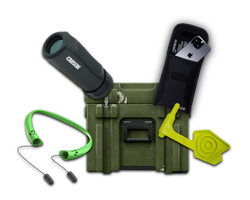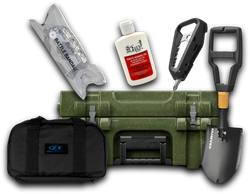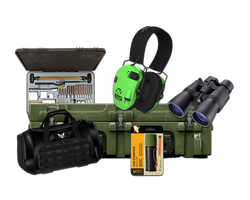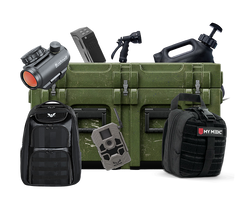How to Sharpen an Axe with File: A Comprehensive Guide
Table of Contents
- Introduction
- Understanding Axe Anatomy and Edge Types
- Selecting the Right File
- Preparing Your Workspace
- Step-by-Step Guide to Sharpening an Axe with a File
- Maintaining Your Axe
- Other Sharpening Methods
- Conclusion
- FAQs
Introduction
Imagine standing in the heart of a dense forest, the scent of pine and earth filling the air as you prepare to chop wood for a warm fire. You reach for your trusty axe, but as you swing, you feel the dullness of the blade and the resistance as it meets the wood – a frustrating moment for any outdoor enthusiast or survivalist. The truth is, a sharp axe is not just more efficient; it's a safer tool, ensuring your hard work pays off without unnecessary strain or risk.
Sharpening an axe is a necessary skill for anyone who regularly engages with outdoor activities, whether you're camping, hiking, or simply maintaining your property. This blog post will guide you through the essential process of sharpening an axe using a file, a method that, while often overlooked, remains effective and accessible.
By the end of this guide, you will understand not only how to sharpen an axe with a file but also the nuances involved in maintaining the blade's integrity, recognizing when a file is the right tool for the job, and the techniques that can enhance your sharpening process. We will cover the types of files best suited for sharpening, the step-by-step process, and best practices to prolong the life of your axe.
Let’s dive into the practical world of axe maintenance, ensuring you're always ready for your next adventure!
Understanding Axe Anatomy and Edge Types
Before we delve into the sharpening process, it's crucial to understand the anatomy of your axe. This knowledge will help you appreciate the sharpening technique we are about to discuss and allow you to tailor your approach to different types of axes.
Axe Anatomy
- Blade (Bit): The cutting edge of the axe, which needs to be sharp.
- Poll: The opposite end of the blade, often used for hammering.
- Heel: The rear part of the cutting edge where the blade meets the axe head.
- Toe: The front part of the cutting edge.
- Handle (Hickory or Fiberglass): The part you grip; often made from durable materials for shock absorption.
Edge Types
Axe blades can be ground to various angles depending on their intended use. Understanding these angles will help you maintain the right sharpness for your specific tasks:
- Chopping Edge: Typically ground to a 20-25 degree angle. This edge is ideal for cutting through wood efficiently.
- Splitting Edge: Usually has a wider angle that helps to split rather than cut through the wood.
- Carving Edge: Finer edges (less than 20 degrees) designed for delicate work.
Having this foundational knowledge ensures that each time you sharpen your axe, you do so with purpose, optimizing it for the tasks you plan to undertake.
Selecting the Right File
Not all files are created equal, and your choice will significantly influence the sharpening process. Here are some key considerations:
Types of Files
- Bastard Cut File: This file is versatile and has a medium cut; it's perfect for initial sharpening.
- Double-Cut File: This file has two sets of teeth, allowing for faster material removal.
- Fine File: Best used for finishing touches, it refines the edge after using a coarser file.
File Material
- High-Carbon Steel Files: Durable and effective for sharpening various steels found in axes.
- Diamond Files: These can be more efficient for harder steels but are typically more expensive.
Choosing a File
When choosing a file for sharpening your axe, consider the hardness of the blade material. If your axe is made of high-carbon steel, a bastard cut file will likely work best. Regularly inspect your file for wear and cleanliness, as clogged files can hinder performance.
Preparing Your Workspace
A clean, organized workspace is essential for effective sharpening. Here’s how to set up:
- Work Surface: Use a sturdy workbench or table.
- Safety Gear: Wear gloves to protect your hands and safety glasses if you're prone to metal filings flying.
- Clamping the Axe: Secure the axe in a bench vise or clamp to keep it stable during the sharpening process.
Step-by-Step Guide to Sharpening an Axe with a File
Now that you have the right tools and workspace, let’s get into the step-by-step process of sharpening your axe.
Step 1: Assess the Edge
Before you start, examine the axe's edge for any chips or damage. If the blade has significant nicks or chips, you may need to start with a coarser file to reshape the edge before moving to finer files.
Step 2: Mark the Edge
Using a permanent marker, draw a line along the edge of the blade. This will provide a visual guide for how much material you need to remove and help you maintain a consistent angle while filing.
Step 3: Position the Axe
Clamp the axe securely to your workbench or table. Ensure the blade is easily accessible and that you have enough room to maneuver the file.
Step 4: File the Blade
- Angle the File: Hold the file at a 20-25 degree angle to the edge.
- Push Stroke: Apply firm pressure as you push the file across the blade, moving away from the cutting edge. Lift the file at the end of each stroke to avoid damaging the blade.
- Clean the File: Use a file card to clean out any metal filings from the teeth of the file every few strokes. This will keep the file cutting effectively.
- Repeat: Continue filing until you see a consistent shine along the edge, indicating that the steel is being removed evenly. Typically, 5-10 strokes on each side will be sufficient.
Step 5: Switch Sides
After sharpening one side, flip the axe over and repeat the filing process on the other side. Be sure to maintain the same number of strokes to keep the edge symmetrical.
Step 6: Refine the Edge
Once you’ve achieved a fine edge with the bastard cut file, switch to a finer file or a sharpening stone to polish the blade further. This step will remove any burrs and create a razor-sharp finish.
Step 7: Test the Sharpness
To test the sharpness of your axe, perform the dry shave test by attempting to shave a small patch of hair from your arm. If the blade glides smoothly without tugging, it’s sharp enough for use. Alternatively, try slicing through a piece of paper. A sharp axe should cut cleanly and easily.
Maintaining Your Axe
Regular maintenance will prolong the life of your axe and ensure it remains safe and effective. Here are some best practices:
Regular Cleaning
After each use, wipe down the blade to remove sap, dirt, and moisture. This will prevent rust and deterioration.
Storage
Store your axe in a dry place. If possible, hang it up to avoid contact with moisture on surfaces. Consider applying a light coat of oil to the blade to protect it from rust.
Periodic Sharpening
Depending on usage, you should sharpen your axe every few months or after heavy use. A quick touch-up with a file can keep it in excellent working condition without requiring a full sharpening session.
Other Sharpening Methods
While using a file is effective, there are alternative methods you might consider, especially for more extensive maintenance:
Using Stones
- Water Stones: Lubricate with water and use in a circular motion to achieve a fine edge.
- Oil Stones: Similar to water stones but require oil for lubrication.
Power Tools
- Belt Sanders: Efficient for re-grinding but require caution to prevent overheating the steel.
- Angle Grinders: Not recommended for sharpening as they often remove too much material and can damage the temper of the blade.
Conclusion
Sharpening an axe with a file is a skill that every outdoor enthusiast and survivalist should master. Not only does it improve efficiency and safety, but it also prolongs the life of your axe. By understanding the anatomy of your axe, selecting the right tools, and following the step-by-step process outlined in this guide, you can maintain a razor-sharp edge ready for any task.
Remember, every time you take care of your axe, you're investing in your safety and enhancing your outdoor experience. Now that you have the knowledge to effectively sharpen your axe, it’s time to put it into practice. Gather your tools, find your workspace, and keep your axe ready for adventure.
FAQs
1. How often should I sharpen my axe?
- The frequency of sharpening depends on usage. For regular use, a quick touch-up after every few uses is advisable. A deeper sharpening may only be necessary every few months.
2. What type of file should I use for my axe?
- A bastard cut file is generally the best first choice for sharpening an axe, followed by a finer file or stone for finishing touches.
3. Can I use a power tool to sharpen my axe?
- While power tools can be used for sharpening, they require careful handling to avoid overheating the blade. It’s often safer to use hand tools, especially for beginners.
4. What should I do if my axe has a significant chip in the blade?
- For large chips, start with a coarser file to reshape the blade before finishing with a finer file or stone.
5. How can I tell if my axe is sharp enough?
- A sharp axe should easily slice through paper or shave hair from your arm without resistance.
6. Is it necessary to lubricate sharpening stones?
- Yes, lubricating stones with oil or water helps to prevent clogging and enhances the sharpening process.
By taking the time to sharpen your axe correctly, you not only enhance its performance but also ensure your safety and enjoyment in the great outdoors. For all your tactical gear and outdoor needs, consider exploring Crate Club's subscription services and shop for expertly curated tools that empower your adventures. You can discover more about their offerings here: Crate Club Subscription Services and Crate Club Shop.
Share this article



